Last week a few friends and I dropped by the Ministry of Transportation’s open house on the future of the Massey Tunnel.
MoT is currently doing “public consultations” on which flavour of tunnel fix/replacement the people like best, following the announcement by soon-to-no-longer-be-Minister-of-Transportation Mary Polak announcement that the tunnel replacement is the next critical piece of transportation infrastructure that needs to be built. Or, to translate roughly: screw you Surrey and UBC/Broadway, we are doubling down on dumb road building ideas from the last century.
At the consultation meetings we were told there would be 5 options for the future of the tunnel:
Option 1:
Fix the Tunnel we have: Upgrade the lights, air-moving, emergency, and other mechanical systems (which are archaic, being built at about the same time as Sputnik, and hardly upgraded since). This would also involve a seismic upgrade of the tunnel to modern standards (and a young engineer in the room assured me this was very feasible, but would not provide a cost), and upgrades to the adjacent intersections at Steveston Hwy and Highway 17.
Option 2:
Replace with a Bridge: This would involve placing a bridge essentially on top of the existing tunnel footprint (again, I was assured they could do this, and who am I to doubt Engineers?). The suggestion was a cable-stayed bridge of similar design to the Port Mann 2, and make no mistake: this bridge will “provide increased capacity for all users”, although no specific lane count was provided.
Option 3:
Replace with a new Tunnel: This would presumably mean digging a new tube adjacent to the exiting one, and one again no lane counts were provided, but “increased capacity” is offered. Tunnels are generally considered to be much more expensive to engineer than a bridge, especially in loose substrates (and this substrate is as loose as they get), so I’m going to go ahead and say this idea is dead in the water (excuse the pun).
Option 4:
Twin it: This would involve doing both Option 1 upgrades to the existing tube, and building another bridge or tunnel next to it to achieve “capacity increase” goals. This is the literal lipstick on the pig option that will not satisfy anyone, as the cost savings in building a 4-lane bridge over an 8-lane (note- my numbers, not theirs! They won’t talk about lane counts!) cannot possibly be more than the cost saved by upgrading the existing tunnel. If they are feeling flush, they will take Option 2, if they are frugal, they will take Option 1, this compromise is unlikely to be Goldilocks’ choice. Dead in the water.
Option 5:
Far-off Sibling: As opposed to twinning in the same spot, this option would keep the tunnel and build another crossing elsewhere: not twins, just siblings. No way Richmond is going to go for this, and the same cost argument for Option 4 exists. Dead in the water.
The other argument for the bridge is, of course, removing a perceived impediment to harbour travel in the Lower Fraser River. Currently, the River is dredged to 11.5m depth (at considerable expense) to allow Panamax ships to pass during most river/tide stages. This won’t be quite enough for fully laden liquid bulk carriers that want to bring Jet Fuel to South Richmond (they will need to be only 80% laden to pass safely).
Suggestions that the River will soon be dredged to “New Panamax” depth of 18m are foolishly optimistic, considering the cost, engineering and environmental challenges that would face anyone attempting to modify the Fraser River that way. Six extra metres of sand for a 250-m-wide path over 30km is what is technically called one hell of a shitload of sand. It would move the saline wedge of the river tens of kilometres upstream, well past where Delta and Richmond farmers draw water to irrigate and harvest crops. I can’t thin of what it would do to fragile salmon stocks or endangered sturgeon. This is a crazy pipe dream. Besides, the Port’s business model is no longer taking things on and off of ships, it is developing real estate for truck warehouses. Why would the Port be interested in spending their own money in dredging rivers when they can enjoy the subsidy of asphalt roads.
The missing point during these consultations was raised several times during the Q&A session: there were no costs mentioned. Not even order-of-magnitude estimates were provided, or “high-medium-low” scaling of costs related to each alternative. Which makes the whole consultation thing a little premature. How can we (the taxpaying road-using public) meaningfully respond to which is best if we don’t have the price?
“Would you rather eat Kobe Beef or a Stouffers Salisbury Steak? Don’t worry about the price, we’ll tell you later which you chose.”
I’m sure the people of Tsawwassen (especially those planning monumental but short-sighted car-oriented retail development) want the biggest, widest bridge they can get (and no tolls, of course), but if you ask the average British Columbian Taxpayer if they want to spend $250 Million fixing the tunnel or $2.5Billion replacing it, you might get a very different answer! (That said, letter writers to the Delta Newspaper are more nuanced in their positions that a smug North-of-Fraser know-it-all like me might have expected)
A final problem with the entire rush-to-consultation before election production is that they are not being straight-up about the “need”. If the tunnel is old and needs repairs: fix the damn thing. If the river draft is a problem: tell us that and make the Port pay for replacement. However, MoT is suggesting that growing congestion is the real driver, but this is not only untrue, they are using the wrong tool to fix it.
First off, Massey Tunnel traffic is going down, and has been for a while. Part of this is less people are driving and more are moving to the alternatives, another part is that the tunnel only avails you to traffic chaos further north. Traffic can only get so congested before the traffic stops arriving. Before anyone replies with “stunting economic growth” argument – this drop in traffic has happened during a time of unprecedented growth in population, industry, and land value on both sides of the tunnel! I’m not sure Delta or Richmond could have tolerated growth faster than it has arrived in the last decade or two.
Secondly, as was pointed out at the consultation meetings by MoT representatives themselves, the real congestion problem at the tunnel is that the vast majority of the vehicles in it are not moving “goods”, or even more than one person. Single Occupant Vehicles represent 77% of the traffic. By comparison, transit represents 1% of the traffic, but moves 26% of the people going through the tunnel:
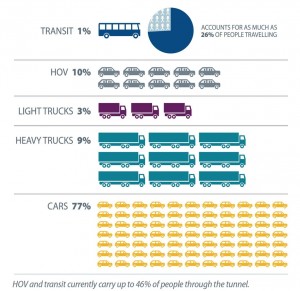 |
| …all images courtesy Ministry of Transportation’s glossy consultation materials, which I didn’t ask permission to use, but hey, I’m a taxpayer, so I paid for them. |
The MoT representative even shared the “surprising” point that of people travelling though the tunnel to get to Vancouver proper, more than 50% were on Transit, not driving. I was only surprised that he was surprised. To anyone who pays any attention to transportation trends in the Lower Mainland, this seems obvious. And it isn’t the result of some fluke of statistics, because This is what Vancouver planned! This is the model set out in the Regional Growth Strategy, in TransLink’s long–term planning documents, in the Livable Region Strategy: this is the model for the region! I find it shocking that an MoT representative would be surprised to find alternative transportation planning works in the Province, and there is data to demonstrate that.
Or maybe I shouldn’t, as we still have a Ministry of Transportation that sees the world through the windshield of their car (or their yellow trucks), and the only transportation plan they understand if roadbuilding. This is why the Minister is sitting in her office off of the Langley Bypass (“best idea for a road ever”), making the Mayors of Surrey and Vancouver fight for the few transit crumbs she may feint to toss their way, while boldly announcing billions for roads to nowhere. This is how she feels no shame in proudly declaring the 10-year-delayed Evergreen Line as “on track”, while making up glossy consultation brochures for the next freeway and while failing to provide basic operating expenses to keep TransLink running busses at the level of service they provided 5 years ago…
So go to the MOT site and fill out the survey they have running until April 2.
Tell them to build the alternatives (light rail or other transit South of Fraser, restoring funding to TransLink, replacing the real goods movement choke point in Greater Vancouver: The 104-year old one-lane Westminster Train Bridge) and they might see the need for this tunnel replacement go away.
Let’s fix the tube we have, and move on to solving real problems.
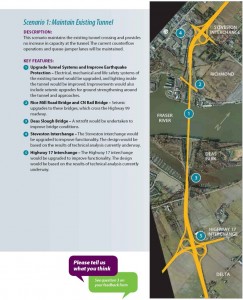
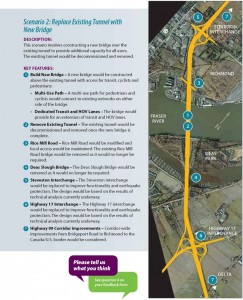
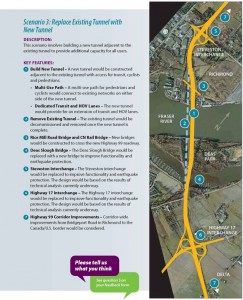
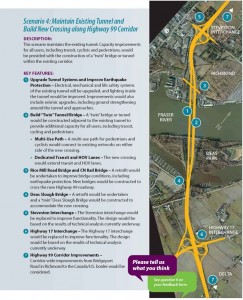
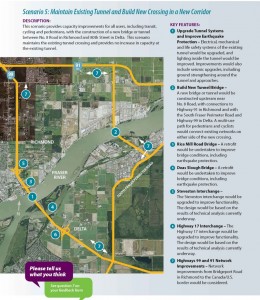
Good point about the rail bridge. After rapid transit on Broadway and in Surrey, that’s my #2 priority project as well, far ahead of any road works project. It is discouraging that we haven’t heard any talk on plans for the rail bridge even though it’s been on the radar of the powers that be for years and years…
Nice write-up. I grew up in Ladner, less than a kilometer away from the Massey Tunnel. I think it’s pretty decent for what it is, especially considering the growth that’s happened in Ladner and Tsawwassen over the past few decades. One problem is that a lot of people in Ladner depend on their cars because they do many things in Vancouver (work, shopping, entertainment), but the public transit between Ladner and Vancouver is a bit lacking. The Ladner Park-and-Ride only holds maybe a couple dozen cars, and the buses are about once-per-hour in most parts of the day, going to once-per-30mins in rush hour I think (although I haven’t paid attention much since I escaped Ladner).
If everyone thinks they need a car to get around and drop their kids at soccer practice and whatever, then they won’t really be motivated to take the really infrequent public transit even when it might happen to suit their needs. So I think that it’ll have to be a sort of “build it and they will come” plan for more buses there. It’ll mean more empty space on the buses for a while until people start realizing that they’re more convenient.